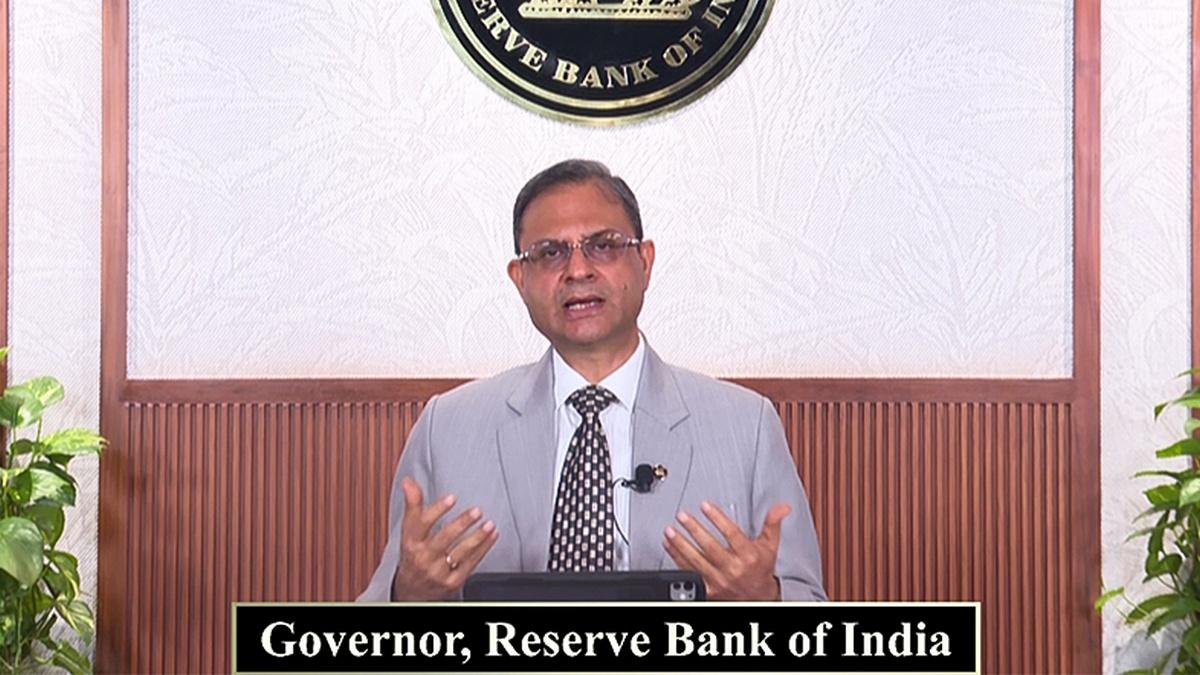‘India has the potential to grow at more than 7%, with the monetary policy providing a supportive hand.’

IMAGE: Reserve Bank of India (RBI) Governor Sanjay Malhotra delivers the Monetary Policy statement, in Mumbai. Photograph: ANI Photo
Ram Singh, external member of the Reserve Bank of India’s (RBI’s) Monetary Policy Committee (MPC), told Manojit Saha/Business Standard in a telephonic interview that lower inflation print than forecast will strengthen the case for a rate cut.
In the MPC minutes, you have said that even if we go by the post-pandemic average neutral interest rate, which was 1.65%, there is scope for approximately a 75 bps cut in the current cycle without overheating the economy. When do you see the next rate cut, in August or later, in Q3?
It is difficult to say whether it will be in August or later; that will depend on how inflation prints turn out vis-a-vis the forecast.
I see there is some scope for a rate cut, but I would also like to see it corroborated by inflation data.
Anything that leads to a lower print than the RBI’s inflation forecast of 3.7 percent for FY 25, will strengthen the case for a rate cut.
When we meet in August, we will also have to see if how the inflation forecast gets revised.
In that context, does the May inflation print, which was lower than what was expected, give you comfort?
Yes, it does. On the flip side, it could result in a higher inflation forecast for the next financial on account of the low inflation base provided by this year.
So we will have to assess the overall effect, because the rate cut policy has to be forward looking. But at the moment a lower than expected print is a source of comfort.
The 50-bps cut has resulted in increases in bond yields, limiting the impact of policy easing. Will this not undermine the intended growth effects of the rate cut?
Yes, it does, to an extent. But its impact is likely to be limited.
In my view, the bond market has overreacted to the MPC’s change in stance from accommodative to neutral.
Given our strong fundamentals — a comfortable fiscal deficit (4.4% of GDP), a low inflation environment and the fastest GDP growth rate among major economies — the FII outflows from the bond market will make only a marginal difference to the overall net forex inflows.
The RBI’s commitment to adequate supply of durable liquidity will also have a stabilising effect on bond yields.
The banks have started transmitting rate cuts for EBR loans, as well as the Marginal Cost of Funds based Lending Rate (MCLR) is a benchmark interest rate used by banks in India to determine the minimum interest rates.
FII have pulled out $ 5 billion out of Indian bonds. Did the MPC foresee how the market could react differently when the stance change was discussed?
We discuss various possible implications of our decisions, including the possible reactions from the market, including the bond market.
When the MPC met, the market was expecting at least 50 basis point cut in this cycle.
That’s the sense I was getting from the commentary emanating from the various segments of the market — banking, money markets, and the bond market.
What they got is a 50-basis-point cut, combined with the change in stance.
These two decisions coming simultaneously have been read as if it is the end of rate cutting cycle. In my view, it is a hasty and partial reading.
Having cut the repo rate by 100 basis points, we want to carefully examine the incoming inflation data, growth data, and also how the international economic and geopolitical situation evolves.
We also would like to assess the extent and pace of the transmission of the 100-bps cut to the real sector of the economy.
The changed stance means that the MPC will now pause and carefully assess the data before considering any further rate cuts.
Given the tariffs related uncertainty and highly fluid geopolitical scenario, the change in stance gives the RBI an additional degree of freedom to respond to unforeseen contingencies.
It does not mean that the rate cutting cycle is over and the rate hikes are next.
There is nothing in the MPC statement to suggest this. It is just that we want to have rooms to address, to respond to all sorts of eventualities.
To me, the direction of bond market reaction is not surprising.
We must note that even though policy rates were cut by 100 basis points, 10-year bond yields had already fallen by about 120 basis points over the 18 months before hardening of the bond yield curve in the aftermath of MPC decision.
If, instead of going for a 50 basis point cut, we had chosen only a 25 basis point cut while maintaining the accommodative stance, implying that there would be another 25 bps cut at the next meeting, the bond market would not have reacted this way.
But two months down the line, with a 100 bps rate cut done and no promise of future cuts, they would have reacted similarly to how they responded to the latest MPC decision.
So, it was only a matter of timing. On the other hand, a staggered rate cut would delay the borrowing, investing and lending decisions for the real sector of the economy.
You want to borrow as cheaply as possible. So, consumers, borrowers, and investors would have delayed their decision, thinking that another 25-basis point cut is around the corner.
Given these trade-offs, I believe we have made the correct choice.

IMAGE: Ram Singh.
Photograph: Kind courtesy, Ram Singh/X
Does the MPC expect credit growth to improve substantially now with this 100 basis point repo rate cut in quick succession?
Yes. I would expect credit growth rates to pick up significantly by the second half of the current financial year.
The RBI governor has assured of sufficient availability of durable liquidity.
The reduction in CRR mitigates the impact of repo rate cuts on net interest margins for banks.
With this support, the banks should not hesitate to transmit the rate cuts.
I expect a significant increase in demand for housing, MSME and other loans, boosting demand.
In fact, I expect the demand to pick up on three counts.
One, the tax concession in Budget 2025 has boosted the purchasing power of the middle class.
Second is the 100-basis-point cut in interest rates.
Third is the increased dividend distribution by companies. This means more income in the bank accounts of individuals and households.
Once demand picks up, private capital expenditure (CAPEX) will also increase.
Corporations have a super healthy balance sheet. You look at the debt-to-equity ratio, and they are unreasonably low.
This rate cut should push the corporates to leverage their balance sheets.
The change in stance to neutral is a signal to decision-makers, such as borrowers and investors, that this might be a good time to execute their decisions.
In your minutes, you claim that India has potential to grow at 7-8%. What evidence do you have to back this claim?
First of all, ipso facto, from FY 2014-15 onwards, out of 11 years, our GDP has seen growth of 6.8% or above, averaging much above 7%.
Over the last several years, core inflation has been lower than the headline inflation, so capital goods inflation has been noticeably lower than the GDP deflator.
This, in turn, means that real investment as a ratio of real GDP is higher than what is commonly claimed.
Furthermore, the Centre’s massive investment in infrastructure, logistics, and technological advances has significantly boosted the productivity of capital.
According to reports, ICOR, which was 7.5 in FY12, is now only 4.4 in FY23 (that is, you need only half of the capital to produce an additional unit of output).
This evidence makes me confident that, we have the potential to grow at more than 7%, with the monetary policy providing a supportive hand.
You have said the neutral interest rate or r* went up for India due to the Covid-19 pandemic-related factors. In your view what should be the r* now, given the real repo rate is at 1.8%?
Since the Covid related problems — increased debt levels, output gaps and pent up demand — are behind us, the neutral interest rate is expected to decline to pre-Covid levels of 1.2%, on average.
An educated guess is that the current neutral rate is between 1.4-1.6%. per cent.
This also opens up the scope for a further rate cut in this cycle itself, if supported by favourable inflation data.
What will give you more comfort for a rate cut? Lower inflation or lower than expected growth?
Inflation is of first-order consideration. I am hoping for a pleasant surprise on the inflation front.
May’s inflation print has surprised on the positive side. If the growth comes under stress, that will also be a consideration.
The weighted average call rate is below the repo rate by 20 bps, on average. Do you think the WACR should be around the repo rate or you think in a surplus liquidity situation, it can be below the repo rate?
Recently, the WACR has been mainly within the LAF corridor, but lower than the repo rate.
In an easing cycle, it is not a matter of concern as the idea is to ensure that no segments of the financial market face any constraints in the transmission of the rate cuts.
It will disturb me only if it leads to some kind of arbitrage or contributes to bubble formation in the asset market.
But at the moment, there are no signs of these concerns. Looking forward, I would expect WACR to align with the repo rate.
Feature Presentation: Rajesh Alva/Rediff




